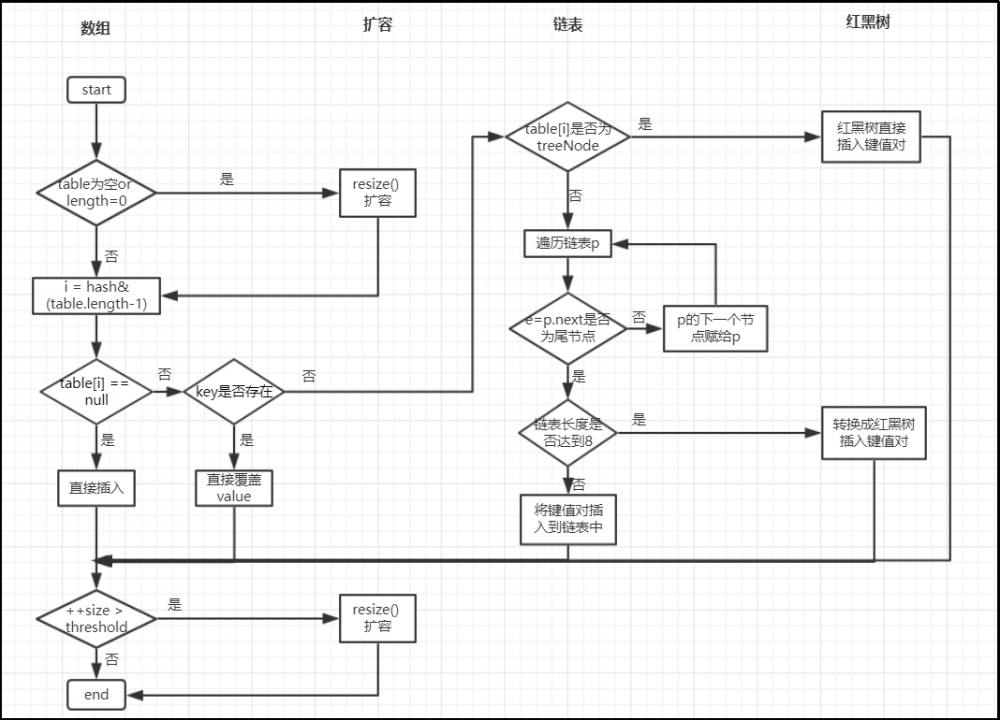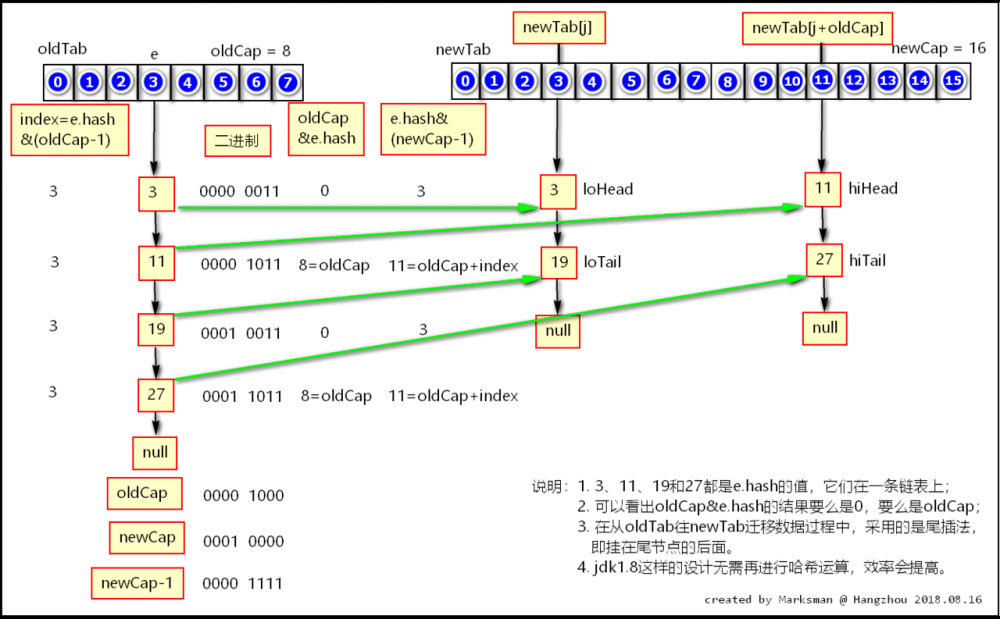Java集合系列之---HashMap
先看下HashMap的继承体系,它继承自抽象类AbstractMap,实现了Map、Cloneable、Serializable接口,还有较常用的子类LinkedHashMap也实现了Map接口。
public class HashMap<K,V> extends AbstractMap<K,V> implements Map<K,V>, Cloneable, Serializable{...
public abstract class AbstractMap<K,V> implements Map<K,V> {...
public class LinkedHashMap<K,V> extends HashMap<K,V> implements Map<K,V>{...
复制代码
再看看HashMap的成员变量和一些默认值:
static final int DEFAULT_INITIAL_CAPACITY = 1 << 4; // 默认的初始化数组大小,16
static final int MAXIMUM_CAPACITY = 1 << 30; // HashMap的最大长度
static final float DEFAULT_LOAD_FACTOR = 0.75f; // 负载因子的默认值
static final Entry<?,?>[] EMPTY_TABLE = {}; // Entry数组默认为空
transient Entry<K,V>[] table = (Entry<K,V>[]) EMPTY_TABLE; // Entry数组
transient int size; // map中key-value 键值对的数量
int threshold; // 阈值,即table.length 乘 loadFactor
final float loadFactor; //负载因子,默认值为 DEFAULT_LOAD_FACTOR = 0.75
transient int modCount; // HashMap结构被修改的次数
static final int ALTERNATIVE_HASHING_THRESHOLD_DEFAULT = Integer.MAX_VALUE; // 阈值的默认值
HashMap.Holder.trasient int hashSeed;//翻译过来叫哈希种子,是一个随机数,它能够减小hashCode碰撞
// 的几率,默认为0,表示不能进行选择性哈希(我也不知道是啥意思)
复制代码
所以我们用默认构造方法new 出来的HashMap(),长度默认为16,阈值为12,并且size达到threshold,就会resize为原来的2倍。
再看下HashMap的一些重要的内部类:
static class Entry<K,V> implements Map.Entry<K,V> {
final K key;
V value;
Entry<K,V> next;
int hash;
Entry(int h, K k, V v, Entry<K,V> n) {
value = v;
next = n;
key = k;
hash = h;
}
}
复制代码
Entry实现了Map的内部接口Entry,它有四个属性,key、value、Entry、hash,是HashMap内数组每个位置上真正存放元素的数据结构。
private final class EntrySet extends AbstractSet<Map.Entry<K,V>> {
public Iterator<Map.Entry<K,V>> iterator() {
return newEntryIterator();
}
public boolean contains(Object o) {
if (!(o instanceof Map.Entry))
return false;
Map.Entry<K,V> e = (Map.Entry<K,V>) o;
Entry<K,V> candidate = getEntry(e.getKey());
return candidate != null && candidate.equals(e);
}
public boolean remove(Object o) {
return removeMapping(o) != null;
}
public int size() {
return size;
}
public void clear() {
HashMap.this.clear();
}
}
复制代码
EntrySet 继承了AbstractSet,它内部有个迭代器iterator,可以获取Entry对象,方法contains用来判断所给的对象是否包含在当前EntrySet中。
put、get、resize方法源码分析
我们知道HashMap,在jdk1.8之前底层用数组+链表实现的,jdk1.8改成了数组+链表+红黑树实现,以避免长链表带来的遍历效率低问题。
JDK-1.7下的源码
- put()方法
public V put(K key, V value) {
if (table == EMPTY_TABLE) { // 首先判断数组若为空,则创建一个新的数组
inflateTable(threshold);
}
if (key == null) // 如果key为null,遍历table数组,如果找出key=null的位置,将value覆
// 盖,并返回旧的value,否则调用addEntry()将它保存到table[0]位
return putForNullKey(value);
int hash = hash(key); // 若key!=null,则计算出hashCode,算出下标 index,遍历table
int i = indexFor(hash, table.length);
for (Entry<K,V> e = table[i]; e != null; e = e.next) {
Object k;
// 若找到hashCode与当前key的hashCode相等,并且key值也相同,
// 那就覆盖value的值,并且放回oldValue
if (e.hash == hash && ((k = e.key) == key || key.equals(k))) {
V oldValue = e.value;
e.value = value;
e.recordAccess(this);
return oldValue;
}
}
modCount++;
// 若没满足(4)中的条件,则调用方法addEntry(...)
addEntry(hash, key, value, i);
return null;
}
private V putForNullKey(V value) {
for (Entry<K,V> e = table[0]; e != null; e = e.next) {
if (e.key == null) {
V oldValue = e.value;
e.value = value;
e.recordAccess(this);
return oldValue;
}
}
modCount++;
addEntry(0, null, value, 0);
return null;
}
static int indexFor(int h, int length) {
// assert Integer.bitCount(length) == 1 : "length must be a non-zero power of 2";
// 长度必须是2的非零幂
return h & (length-1); //table数组的下标计算:hashCode与(table数组长度减一)做与(&)运算
}
&运算,即同是1才为1,否则为0
例如:h1=3 h2=20 length=16
h1: 0011
h2: 10100
length-1: 1111
h1(index): 0011 = 3
h2(index): 0100 = 4
这样运算得出的index就是舍弃了hashCode一部分高位的hash的值
复制代码
若indexFor计算出来的下标在数组中不为空并且size达到阈值,则扩容,然后在index位置创建一个Entry,将key-value放进去。
void addEntry(int hash, K key, V value, int bucketIndex) {
if ((size >= threshold) && (null != table[bucketIndex])) {
resize(2 * table.length);
hash = (null != key) ? hash(key) : 0; // null的hashCode为0
bucketIndex = indexFor(hash, table.length);
}
createEntry(hash, key, value, bucketIndex);
}
void createEntry(int hash, K key, V value, int bucketIndex) {
Entry<K,V> e = table[bucketIndex];
table[bucketIndex] = new Entry<>(hash, key, value, e);
size++;
}
复制代码
- get()方法
public V get(Object key) {
if (key == null) // 如果key为null,则判断HashMap中是否有值,若没有直接返回null
return getForNullKey();
Entry<K,V> entry = getEntry(key); return null == entry ? null : entry.getValue();
// 最后获取Entry的value,并返回
}
private V getForNullKey() { // 若有就遍历table数组,找到null对应的value并返回
if (size == 0) {
return null;
}
for (Entry<K,V> e = table[0]; e != null; e = e.next) {
if (e.key == null)
return e.value;
}
return null;
}
// 若key不为null,则获取Entry,也就是一个遍历table数组命中的过程
final Entry<K,V> getEntry(Object key) {
if (size == 0) {
return null;
}
int hash = (key == null) ? 0 : hash(key);
for (Entry<K,V> e = table[indexFor(hash, table.length)];
e != null;
e = e.next) {
Object k;
if (e.hash == hash &&
((k = e.key) == key || (key != null && key.equals(k))))
return e;
}
return null;
}
复制代码
- resize()方法
void resize(int newCapacity) {
Entry[] oldTable = table;
int oldCapacity = oldTable.length;
// 首先将当前对象的一些属性保存起来,如果当前HashMap的容量达到最大值,那就无法扩容了,将阈值
// 设置为Integer的最大值并结束方法
if (oldCapacity == MAXIMUM_CAPACITY) {
threshold = Integer.MAX_VALUE;
return;
}
// 否则创建新的Entry数组,长度为newCapacity,在addEntry()方法中,
// 我们知道 newCapacity = 2 * table.length
Entry[] newTable = new Entry[newCapacity];
// 然后调用transfer()方法,此方法的作用是将当前数组中的Entry转移到新数组中
transfer(newTable, initHashSeedAsNeeded(newCapacity));
table = newTable;
threshold = (int)Math.min(newCapacity * loadFactor, MAXIMUM_CAPACITY + 1);
}
复制代码
在存入key-value时会调用initHashSeedAsNeeded()方法判断是否需要rehash,该方法的过程见注释,好吧,我也不知道为什么这样处理得出的结果就能 判断是否需要rehash,后面就是根据rehash重新计算下标,并将key-value存入新的table中。
/**
* Transfers all entries from current table to newTable.
*/
void transfer(Entry[] newTable, boolean rehash) {
int newCapacity = newTable.length;
for (Entry<K,V> e : table) {
while(null != e) {
Entry<K,V> next = e.next;
if (rehash) {
e.hash = null == e.key ? 0 : hash(e.key);
}
int i = indexFor(e.hash, newCapacity);
e.next = newTable[i];
newTable[i] = e;
e = next;
}
}
}
/**
* Initialize the hashing mask value. We defer initialization until we really need it.
*/
final boolean initHashSeedAsNeeded(int capacity) {
boolean currentAltHashing = hashSeed != 0; // 当前哈希种子是否为0
boolean useAltHashing = sun.misc.VM.isBooted() &&
// 虚拟机是否启动,当前数组容量是否大于阈值
(capacity >= Holder.ALTERNATIVE_HASHING_THRESHOLD);
boolean switching = currentAltHashing ^ useAltHashing; // 做异或运算
if (switching) {
// 重置哈希种子
hashSeed = useAltHashing ? sun.misc.Hashing.randomHashSeed(this) : 0;
}
return switching; // 返回异或运算的结果,作为是否rehash的标准
}
复制代码
JDK-1.8下的源码
jdk1.8中将Entry改为Node节点来实现的,属性都是一样的。
- put()方法
public V put(K key, V value) {
return putVal(hash(key), key, value, false, true);
}
final V putVal(int hash, K key, V value, boolean onlyIfAbsent,boolean evict) {
Node<K,V>[] tab; Node<K,V> p; int n, i;
// 如果数组是null或者数组为空,就调用resize()进行初始化
if ((tab = table) == null || (n = tab.length) == 0)
n = (tab = resize()).length;
// (n-1)&hash 算出下表,这个和1.7是一样的
if ((p = tab[i = (n - 1) & hash]) == null)
// 如果当前计算出来的位置为null,就新建一个节点
tab[i] = newNode(hash, key, value, null);
else {
Node<K,V> e; K k;
if (p.hash == hash && ((k = p.key) == key ||
// 若计算出来的位置上不为null,它和传入的key相比,hashCode相等并且key也相等
(key != null && key.equals(k))))
// 那么将p赋给e
e = p;
// 如果p是树类型
else if (p instanceof TreeNode)
// 则按照红黑树的结构存入进去
e = ((TreeNode<K,V>)p).putTreeVal(this, tab, hash, key, value);
else {
// 遍历p,p是链表
for (int binCount = 0; ; ++binCount) {
// 如果p的下一个节点是尾节点(尾节点.next=null)
if ((e = p.next) == null) {
// 在p的后面创建一个节点,存放key/value(尾插法,多线程并发不会形成循环链表)
p.next = newNode(hash, key, value, null);
// TREEIFY_THRESHOLD = 8,即当binCount达到7时转换成红黑树数据结构,因为binCount是从0开始
// 的,达到7时p链表上就有8个节点了,所以是链表上达到8个节点时会转变成红黑树。
if (binCount >= TREEIFY_THRESHOLD - 1)
// 这里先就不展开了,红黑树不会,有时间再研究
treeifyBin(tab, hash);
break;
}
if (e.hash == hash && ((k = e.key) == key || (key != null && key.equals(k))))
break;
// 若上面两个条件都不满足,此时e=p.next,也就是将p的下一个节点赋给p,进入下一次循环
p = e;
}
}
// existing mapping for key,jdk这段注释意思是存在key的映射,我的理解是传入的key 在p位置找
// 到它自己的坑被别人占了
if (e != null) {
V oldValue = e.value;
// 下面就是将value存入被占的位置,并将旧的value返回
if (!onlyIfAbsent || oldValue == null)
e.value = value;
afterNodeAccess(e);
return oldValue;
}
}
// 修改次数加一
++modCount;
// 若已有的键值对数大于阈值,就扩容
if (++size > threshold)
resize();
afterNodeInsertion(evict);
return null;
}
复制代码
put方法流程图如下:

- get()方法
public V get(Object key) {
Node<K,V> e;
return (e = getNode(hash(key), key)) == null ? null : e.value;
}
final Node<K,V> getNode(int hash, Object key) {
Node<K,V>[] tab; Node<K,V> first, e; int n; K k;
if ((tab = table) != null && (n = tab.length) > 0 &&
(first = tab[(n - 1) & hash]) != null) {
if (first.hash == hash && // always check first node
((k = first.key) == key || (key != null && key.equals(k))))
return first;
if ((e = first.next) != null) {
if (first instanceof TreeNode)
return ((TreeNode<K,V>)first).getTreeNode(hash, key);
do {
if (e.hash == hash &&
((k = e.key) == key || (key != null && key.equals(k))))
return e;
} while ((e = e.next) != null);
}
}
return null;
}
复制代码
get()方法也没什么,就是根据key的hashCode算出下标,找到对应位置上key与参数key是否相等,hash是否相等,如果是树就获取树的节点,如果是链表就遍历直到找到为止,找不到就返回null。
- resize()方法
final Node<K,V>[] resize() {
Node<K,V>[] oldTab = table;
// oldCap就是原数组的长度
int oldCap = (oldTab == null) ? 0 : oldTab.length;
// 原阈值
int oldThr = threshold;
int newCap, newThr = 0;
if (oldCap > 0) {
if (oldCap >= MAXIMUM_CAPACITY) {
threshold = Integer.MAX_VALUE;
return oldTab;
}
else if ((newCap = oldCap << 1) < MAXIMUM_CAPACITY &&
oldCap >= DEFAULT_INITIAL_CAPACITY)
// double threshold 扩容成两倍
newThr = oldThr << 1;
}
else if (oldThr > 0) // initial capacity was placed in threshold
newCap = oldThr;
// zero initial threshold signifies using defaults, 这里表示初始化resize的另一个作用
else {
newCap = DEFAULT_INITIAL_CAPACITY;
newThr = (int)(DEFAULT_LOAD_FACTOR * DEFAULT_INITIAL_CAPACITY);
}
if (newThr == 0) {
float ft = (float)newCap * loadFactor;
newThr = (newCap < MAXIMUM_CAPACITY && ft < (float)MAXIMUM_CAPACITY ?
(int)ft : Integer.MAX_VALUE);
}
threshold = newThr;
@SuppressWarnings({"rawtypes","unchecked"})
// 创建新数组,容量为原数组的两倍
Node<K,V>[] newTab = (Node<K,V>[])new Node[newCap];
// 将它指向table变量
table = newTab;
if (oldTab != null) {
// 遍历原数组
for (int j = 0; j < oldCap; ++j) {
Node<K,V> e;
// 将不为null的j位置的元素指向e节点
if ((e = oldTab[j]) != null) {
oldTab[j] = null;
if (e.next == null)
// 若e是尾节点,或者说e后面没有节点了,就将e指向新数组的e.hash&(newCap-1)位置
newTab[e.hash & (newCap - 1)] = e;
else if (e instanceof TreeNode)
// 如果是树节点,就按红黑树处理,这里不展开
((TreeNode<K,V>)e).split(this, newTab, j, oldCap);
else { // preserve order
// 存放新数组中原位置的节点,这里后面展开说
Node<K,V> loHead = null, loTail = null;
// 存放新数组中原位置+原数组长度的节点
Node<K,V> hiHead = null, hiTail = null;
Node<K,V> next;
do {
next = e.next;
// e.hash&oldCap 的值要么是0要么是oldCap ###
if ((e.hash & oldCap) == 0) {
if (loTail == null)
// 第一次进来,先确定头节点,以后都走else,loHead指向e
loHead = e;
else
// 第二次进来时loTail的next指向e(e=e.next),注意此时loHead的地址和loTail还是一样的,
// 所以loHead也指向e,也就是说e被挂在了loHead的后面(尾插法,不会形成循环链表),
// 以此类推,后面遍历的e都会被挂在loHead的后面。
loTail.next = e;
// loTail指向e,第一次进来时头和尾在内存中的指向是一样的都是e,第二次进来时,
// loTail指向了e(e=e.next),这时和loHead.next指向的对象是一样的,所以下一次
// 进来的时候loHead可以找到loTail.next,并将e挂在后面。
// 这段不明白的可以参考:https://blog.csdn.net/u013494765/article/details/77837338。
loTail = e;
}
else { // 和if里面的原理是一样的
if (hiTail == null)
hiHead = e;
else
hiTail.next = e;
hiTail = e;
}
} while ((e = next) != null);
if (loTail != null) {
loTail.next = null;
newTab[j] = loHead; // 将loHead节点存到新数组中原下标位置
}
if (hiTail != null) {
hiTail.next = null;
// 将hiHead节点存到新数组中 [原下标+原数组长度] 的位置
newTab[j + oldCap] = hiHead;
}
}
}
}
}
return newTab;
}
复制代码
这里争对 ### 标注的代码详细讲下:
为什么(e.hash&oldCap) == 0为true或false就能判断存放的位置是newTab[原下标],还是newTab[原下标+原数组长度],而不用像jdk1.7那样每次都要rehash?

JDK-1.7多线程并发形成循环链表问题

并发访问HashMap会出现哪些问题,如何解决呢?
经过上面分析,我们知道jdk1.8已经不会在多线程下出现循环链表问题了,那还会出现哪些问题呢? 如:数据丢失、结果不一致...... 解决方案:
- HashTable
用synchronized锁住整个table,效率太低,不好。
- Collections.SynchronizedMap()
它是对put等方法用synchronized加锁的,效率一般是不如ConcurrentHashMap的,用的不多。
- ConcurrentHashMap
jdk1.8以前底层是数组+链表,并采用锁分段,segment,每次对要操作的那部分数据加锁,并且get()是不用加锁的,这效率就高多了;
jdk1.8开始底层采用数组+链表+红黑树,并放弃锁分段,而采用CAS + synchronized技术实现,效率更高 。具体实现原理,且听下回分解。
最后:文中若有写的不对或者不好的地方,请各位看官指出,谢谢。
参考:
- HashMap? ConcurrentHashMap? 相信看完这篇没人能难住你!
- Java8系列之重新认识HashMap
- Java 1.8中HashMap的resize()方法扩容部分的理解
- 本文标签: Collections ACE 线程 equals CEO 锁 源码 Java集合 并发 多线程 DOM http ConcurrentHashMap 注释 参数 翻译 Collection 数据 zab 遍历 ask https HashTable 时间 value java IO UI synchronized App src node HashMap rand 代码 key 1111 map 构造方法 CTO final tab id tk SDN
- 版权声明: 本文为互联网转载文章,出处已在文章中说明(部分除外)。如果侵权,请联系本站长删除,谢谢。
- 本文海报: 生成海报一 生成海报二











![[HBLOG]公众号](https://www.liuhaihua.cn/img/qrcode_gzh.jpg)

